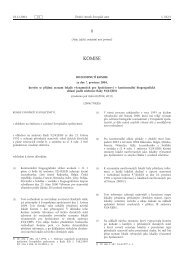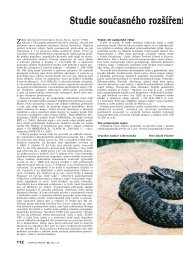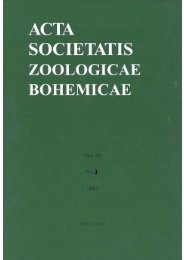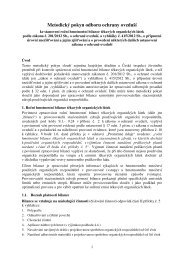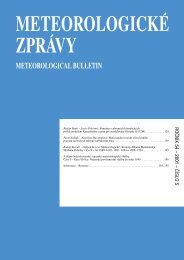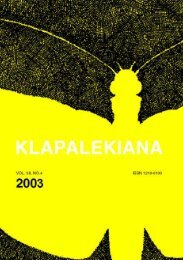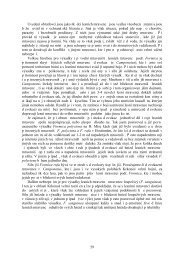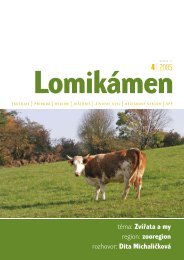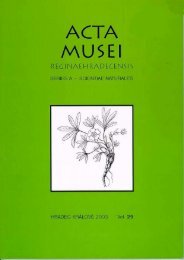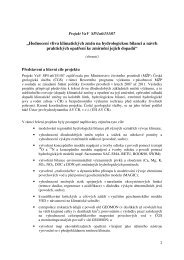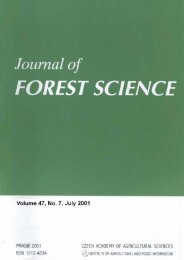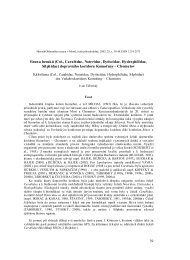Distribution and taxonomy of some Synapsis species, with ...
Distribution and taxonomy of some Synapsis species, with ...
Distribution and taxonomy of some Synapsis species, with ...
You also want an ePaper? Increase the reach of your titles
YUMPU automatically turns print PDFs into web optimized ePapers that Google loves.
HT male <strong>of</strong> Silpha obscura ablattaroides (MNHN, coll. generale), labelled “Utsch-Déré / Caucasus / STARCK<br />
DEDIT [p, label <strong>with</strong> black frame] // S. obscura / subsp. ablattaroides / m. [hw, Portevin’s MS] // TYPE [p, red<br />
label] // Museum Paris [p] // Silpha / obscura obscura / Linnaeus, 1758 / Jan R%ži!ka det. 2002 [p]”.<br />
COMMENTS. Silpha obscura is a widely distributed Palaearctic <strong>species</strong>, known from Europe to<br />
eastern Siberia (Schawaller 1980). Schawaller (1980) reviewed this polymorphic <strong>species</strong> <strong>and</strong> recognized<br />
six valid sub<strong>species</strong>; he treated other associated names as junior synonyms (see Schawaller<br />
1980: 7–8 for details). Recently, Nikolaev & Kozminykh (2002) changed position <strong>of</strong> two names,<br />
established as valid by Schawaller (1980).<br />
Ménétries (1832) described Silpha costata from Lenkoran, based on an unknown number <strong>of</strong><br />
specimens. He characterized it as having distinctly punctured, flat elytra <strong>with</strong> distinctly marked<br />
costae. S. costata Ménétries, 1832 is a senior primary homonym <strong>of</strong> S. costata Brullé, 1836 (treated<br />
here as a objective synonym <strong>of</strong> S. figurata Brullé, 1839, see discussion under Heterotemna figurata<br />
above). Silpha costata Ménétries, 1832 was usually treated as a variety <strong>of</strong> S. obscura Linnaeus,<br />
1758 (e.g. by Portevin 1926), Schawaller (1980) considered it as a junior synonym <strong>of</strong> S. obscura<br />
obscura. Recently, Nikolaev & Kozminykh (2002) followed the old meaning <strong>of</strong> Reitter (1884), <strong>and</strong><br />
changed position <strong>of</strong> S. costata Ménétries, 1832 to that <strong>of</strong> a variety <strong>of</strong> S. tristis Illiger, 1789. I have<br />
examined the syntype <strong>of</strong> S. costata Ménétries, 1832 (designated here as a lectotype) <strong>and</strong> considered<br />
it identical <strong>with</strong> S. obscura obscura from central Europe.<br />
Ménétries (1832) described Silpha striola from “Caucase”, based on an unknown number <strong>of</strong><br />
specimens. He characterized it as having a black body, finely punctate dorsum <strong>and</strong> only finely<br />
marked elytral costae. Portevin (1926) treated this taxon only as S. obscura var. striola. Schawaller<br />
(1980) considered this name as a junior subjective synonym <strong>of</strong> S. obscura obscura, naming populations<br />
from Caucasus <strong>and</strong> north-western Iran incorrectly as S. obscura nitida (described from<br />
Kashmir, see below). Nikolaev & Kozminykh (2002) pointed out this error, <strong>and</strong> changed position <strong>of</strong><br />
S. striola to that <strong>of</strong> a valid sub<strong>species</strong> <strong>of</strong> S. obscura, distributed in southern Russia, Caucasus <strong>and</strong><br />
Transcaucasia. I examined a syntype <strong>of</strong> S. striola (designated here as a lectotype) <strong>and</strong> many<br />
specimens deposited in JRUC, JSSC <strong>and</strong> NMPC, coming from Caucasus <strong>and</strong> the Transcaucasia,<br />
<strong>and</strong> consider the variation in elytral structure similar to that <strong>of</strong> <strong>some</strong> specimens <strong>of</strong> S. obscura<br />
obscura from central Europe; also the curvature <strong>of</strong> the inner margin <strong>of</strong> the paramera <strong>and</strong> extent <strong>of</strong><br />
preapical lateral constriction <strong>of</strong> aedeagus (character pointed out by Schawaller 1980) are variable,<br />
overlapping <strong>with</strong> <strong>some</strong> central European specimens <strong>of</strong> S. obscura obscura.<br />
Reiche (1861) described Silpha godarti from Crimea, based on an unknown number <strong>of</strong> specimens.<br />
He distinguished it from similar S. orientalis Brullé, 1832 as having a larger body <strong>and</strong> denser<br />
<strong>and</strong> finer punctation <strong>of</strong> elytra. Later, Portevin (1926) treated this name only as a variety <strong>of</strong> S.<br />
orientalis. Schawaller (1980) changed position <strong>of</strong> S. orientalis to that <strong>of</strong> a sub<strong>species</strong> <strong>of</strong> S. obscura,<br />
applied to populations from south Europe to Near East. He listed S. godarti as a junior synonym<br />
<strong>of</strong> S. obscura orientalis, but figured the presence <strong>of</strong> S. obscura obscura from Ukraine (incl.<br />
Crimea) on distributional map <strong>of</strong> S. obscura. I have examined a large specimen from Crimea (deposited<br />
in JRUC) <strong>and</strong> find no substantial differences between them <strong>and</strong> S. obscura obscura from<br />
central Europe.<br />
Semenov (1891) described Silpha obscura var. simplex, based on a single specimen from “Altai<br />
mer., montes Kolbinenses”. He distinguished it from the nominotypical form mainly by very slightly<br />
indicated elytral costae. Later, Schawaller (1980) treated this name as S. obscura simplex <strong>and</strong><br />
applied it for populations from the environs <strong>of</strong> the Balkhash lake. Recently, Nikolaev & Kozminykh<br />
(2002) discussed briefly its status <strong>and</strong> speculated about its probable position as a junior synonym<br />
<strong>of</strong> S. obscura obscura. I have examined the holotype <strong>of</strong> S. obscura var. simplex <strong>and</strong> followed the<br />
311



